Main navigation
Researched and Written by
Dr. Fred Stamler
Harry Pratt (H.P.) Smith became Professor and Head of the Department of Pathology and Bacteriology at Iowa in 1930 and remained for 15 years before accepting a similar position at Columbia University in 1945. He was a native Iowan, born near West Branch, who had spent most of his youthful years in Oklahoma, on land homesteaded by his parents. From there he had gone farther West to attend the University of California at Berkeley. There he received a BA degree in 1916 and an M.D. degree in 1921. As a medical student he had come under the influence of Dr. George H. Whipple, and had completed his first experimental projects as a student fellow under Dr. Whipple’s’ tutelage. Following graduation from Berkeley, he spent several years in the Johns Hopkins Department of Pathology, where he continued his experimental studies. Following this he spent a year as a National Research Fellow in Chemistry. In the meantime, Dr. Whipple had become Dean and Head of Pathology at the new medical college at Rochester, New York. Whipple chose H.P. Smith as his first associate professor and he remained as Whipple’s senior staff associate in Pathology until his move to Iowa City.
H.P. Smith came to his new position resolved to establish within the Department a strong center of experimental pathology such as he had known at Berkeley, Baltimore, and Rochester. He had come to know Emory Warner at Rochester, and brought him back to Iowa City as his senior associate. From the beginning, Dr. Warner was given major responsibility in departmental research, teaching, and patient care.
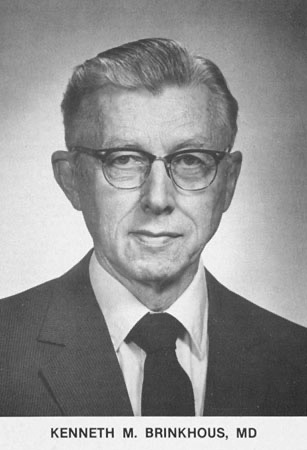
Dr. Kenneth Brinkhous, an Iowa graduate who spent one year with Whipple at Rochester, joined the staff in 1932.
Dr. Smith had decisive views concerning attitudes and qualifications necessary for a successful career in basic medical research, and a firm belief in the value of taking direct action to correct perceived deficiencies in these attributes. Since the German literature was the most important repository of knowledge about blood coagulation at the time, he believed that he and his staff must acquire proficiency in that language if they hoped to succeed as researchers in that field. Consequently, tutoring service was arranged with a senior member of the University German Department, and many evening and weekend hours were given over to the quest of mastery of scientific German. Knowledge of principles of advanced mathematics was also deemed essential by Dr. Smith, so his new associates were persuaded to audit courses in calculus and statistics. These extracurricular studies were continued for most of the years of Dr. Smith’s tenure at Iowa, and sometimes included rotating surgery residents and student fellows.
The trio of Smith, Warner and Brinkhous formed an exceptional team, with complementary personalities and skills which enabled them to work together in harmony and with great productivity. Walter Seegers, PhD was an early addition to the group whose expertise in Biochemistry added much to the group efforts in the identification, purification, and quantification of blood coagulation factors.
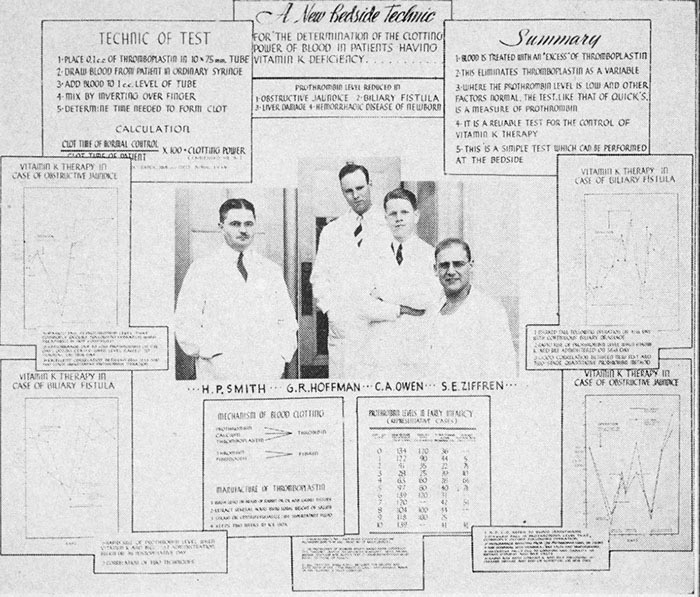
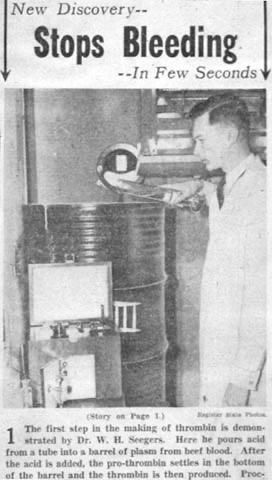
The group pioneered studies in the role of Vitamin K in blood coagulation, and added materially to knowledge concerning the role of liver function and bile excretion in the coagulation process. Their pioneer work enabled them to publish (1938) the first report of successful treatment with Vitamin K of life-threatening hemorrhage in a jaundiced patient with prothrombin deficiency.
The successful efforts by the Iowa group to purify and concentrate coagulation components lead to development of mass production methods for thrombin and other products. Patents were obtained, and Parke Davis was awarded rights to process and market these products. A non-profit corporation was formed to receive funds resulting from this enterprise, which continued to be profitable for the duration of the patents. Funds accruing to the corporation were used solely for education and research. At the final dissolution of the corporation, each member was given the option of designating the disposition of his share of remaining funds. Dr. Warner chose to donate his share to the Department for the establishment of a research fellowship which is in operation to this day.
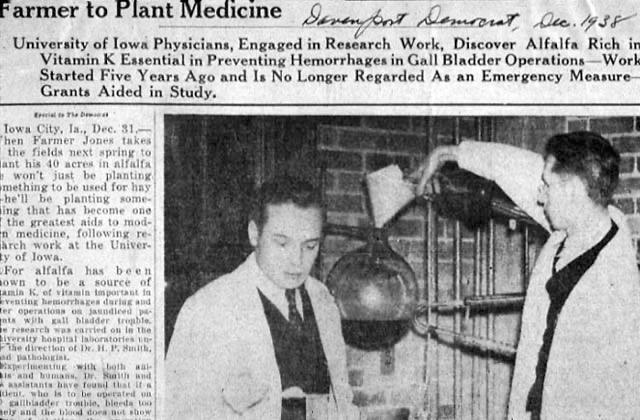
The Department under went a major change in 1933, when the Division of Bacteriology was placed in the Department of Hygiene and Preventive Medicine. In 1938 Bacteriology was given departmental status, with Dr. William Hale as Professor and Head. Years later it became known as the Department of Microbiology.
The change in departmental structure in 1933 was accompanied by major changes in personnel. The names of Drs. George Herman Hansmann, John Rudolph Schenken, and John J. Clemmer all disappeared from the roster that year. Dr. John Wesley Budd and others had departed somewhat earlier, so that now the Hansmann era was truly at an end at Iowa.
With the deletion of Bacteriology from the Department, the remaining staff had decreased responsibilities, and could now concentrate more efficiently on teaching and service in Anatomical Pathology, in addition to continuing emphasis on experimental pathology. The work load was still heavy, since the Department covered Mercy Hospital’s pathology needs in addition to those of University Hospital. Pathology had become the major course of the sophomore year of the Medical College, and all members of the Department were obliged to contribute to its completion.
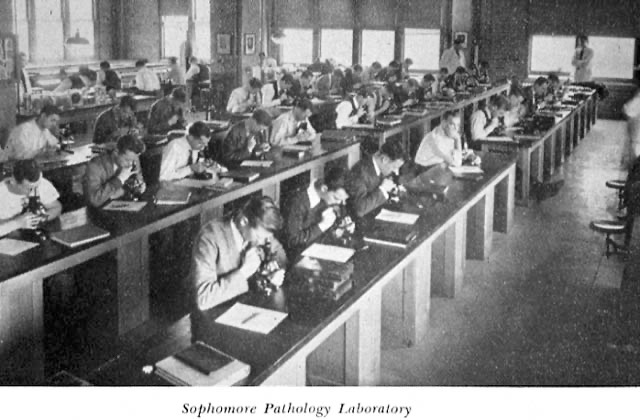
Surgery residents constituted an important component of the Pathology work force. It had long been customary to include a year of Pathology in the Surgery residency programs and that practice continued until World War II. Most Surgery residents worked mainly on the Autopsy and Surgical Pathology services, with variable amounts of time allotted to medical student teaching. In addition, several contributed materially to departmental research. This was especially true of Robert Tidrick and Sidney Ziffren who both later served terms as Surgery Department Heads at Iowa.
The department did not have a structured residency program, as now known, during the Smith era, but customarily had several young staff members who planned a career in Pathology, either in academics or private practice. These included Drs. Roland S. Aronson (1933-47), Harvey S. Smith (1938-39), Joseph E. Glynn (1939-49), Eugene J. Boyd (1940-41, 1945-52), Willard S. Pheteplace (1942-45) and John R. Carter (1944-46, 1948-60).
Early in his tenure at Iowa, Dr. Smith introduced a program for Student Fellows, similar to ones which Dr. Whipple had offered at Berkeley and later at Rochester. Each year a post-sophomore medical student was selected to work within the department for one year. Research activity was stressed, but fellows were expected to do a fair share of student teaching, as well as routine autopsy and surgical pathology duty. Student fellows of early years included George Hoffman, Lester Hoyt, Charles Owen, Sheldon Walker, Fred Stamler, and George Chambers. This program was interrupted by World War II, but was later resumed under the headship of Dr. Emory Warner. Of the first six fellows, three remained in Pathology; one chose Dermatology; one Orthopaedics, and one Urology.
As World War II threatened, and manpower demands increased, Dr. Smith became greatly concerned about efficiency of performance in all areas. Technicians were required to schedule their work in detail, and were accountable for each 15-minute increment. All personnel were encouraged to account for each minute of their time. Secretarial help became so scarce during the war years, that at times surgical pathology reports were not typed, but returned to the patient’s charts in abbreviated handwritten form. By the spring of 1945 the departmental roster,
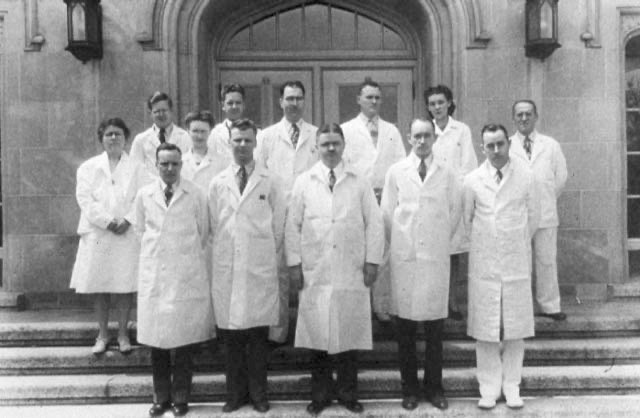
including one secretary, four technicians, and a morgue attendant, had dwindled to thirteen, to be further depleted by Dr. Smith’s departure July 1.
Dr. Smith left Iowa City in 1945 to become Head of Pathology at Columbia University, and held that position until retirement fifteen years later. During his later academic years his emphasis shifted to the rapidly developing practice of Clinical Pathology. He was acutely aware of the problems this presented to most academic departments, which were designed principally to meet the demands of teaching and service in Anatomic pathology. He was a staunch supporter of the American Society of Clinical Pathologists and the College of American Pathologists. He became an authority on medical politics and policies, and after retirement at Columbia he created a new position for himself as "librarian" for the ASCP. The society honored him with its Ward Burdick Award and Distinguished Service Award. After a second "retirement" he became active in the Pathology Department at Columbia, Missouri, until his death at age 75 on April 12, 1972.
Among Dr. Smith’s associates at Columbia University several later attained prominence. Those becoming department heads included Joseph Flynn (University of Missouri), Wellington B. Stewart (University of Kentucky), Robert Coon (University of Vermont), Richard Naeye (Hershey, Pennsylvania) and Fred Lucas, who succeeded Flynn at Missouri. Donald West King held successive headships at Colorado and Columbia University before becoming Dean and Vice President of the Division of Medical Science at the University of Chicago.